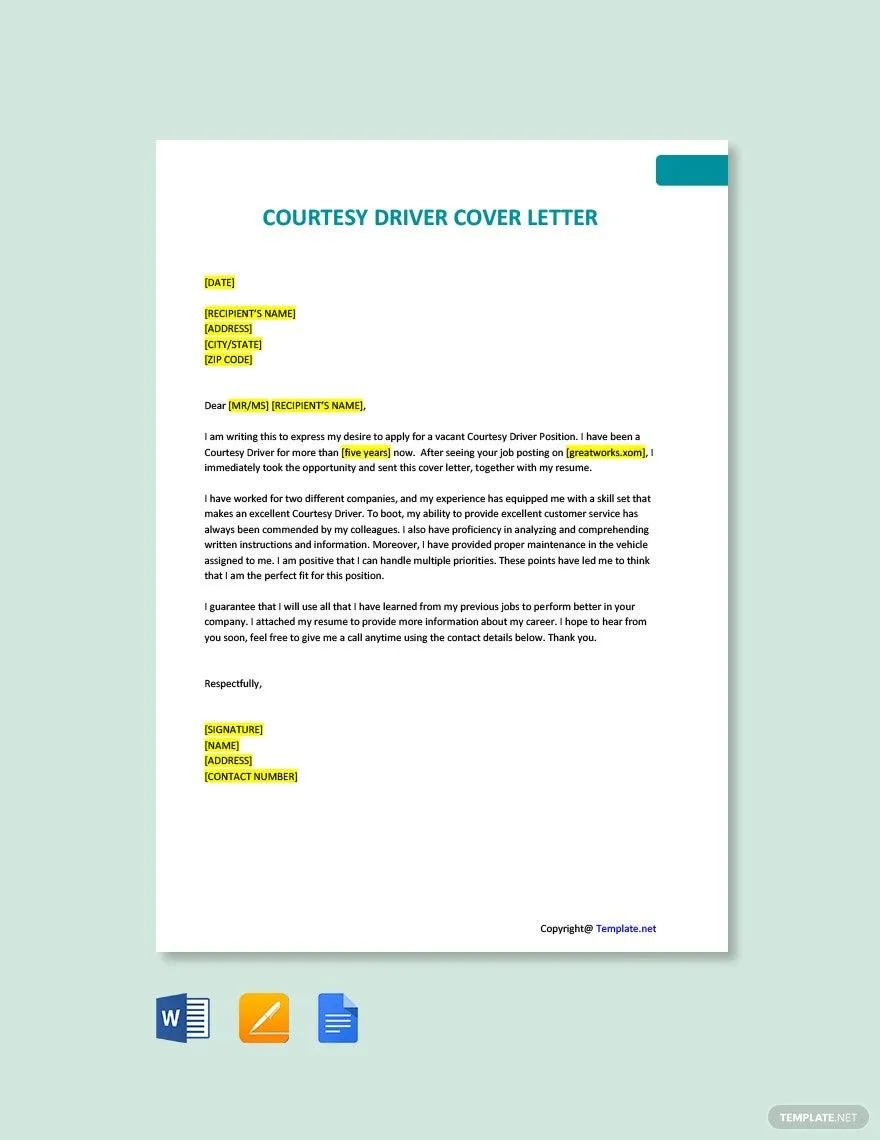Crafting a Driver Cover Letter
A driver cover letter is a crucial document in your job application, acting as your first impression on potential employers. Unlike a resume, which provides a factual account of your work history, a cover letter allows you to showcase your personality, passion, and specific qualifications that make you an ideal candidate. It’s your chance to go beyond the basics and demonstrate why you’re the perfect fit for the driving position. A well-crafted cover letter can significantly increase your chances of landing an interview, so it’s essential to dedicate time and effort to make it stand out from the competition. This comprehensive guide will equip you with the knowledge and tools needed to write a compelling driver cover letter that gets results, helping you secure your dream driving job.
Understanding the Purpose of a Driver Cover Letter
The primary purpose of a driver cover letter is to introduce yourself to the hiring manager and express your interest in the specific driving position. It provides context for your resume, explaining how your skills, experience, and qualifications align with the job requirements. Furthermore, the cover letter is your opportunity to highlight your unique selling points, such as your excellent driving record, experience with specific vehicle types, or any specialized training you may possess. It’s not just about listing your credentials; it’s about connecting with the reader on a personal level and demonstrating your enthusiasm for the opportunity. Think of it as your personal marketing tool, selling your abilities and making a strong case for why you should be considered for an interview.
Highlighting Key Skills and Qualifications
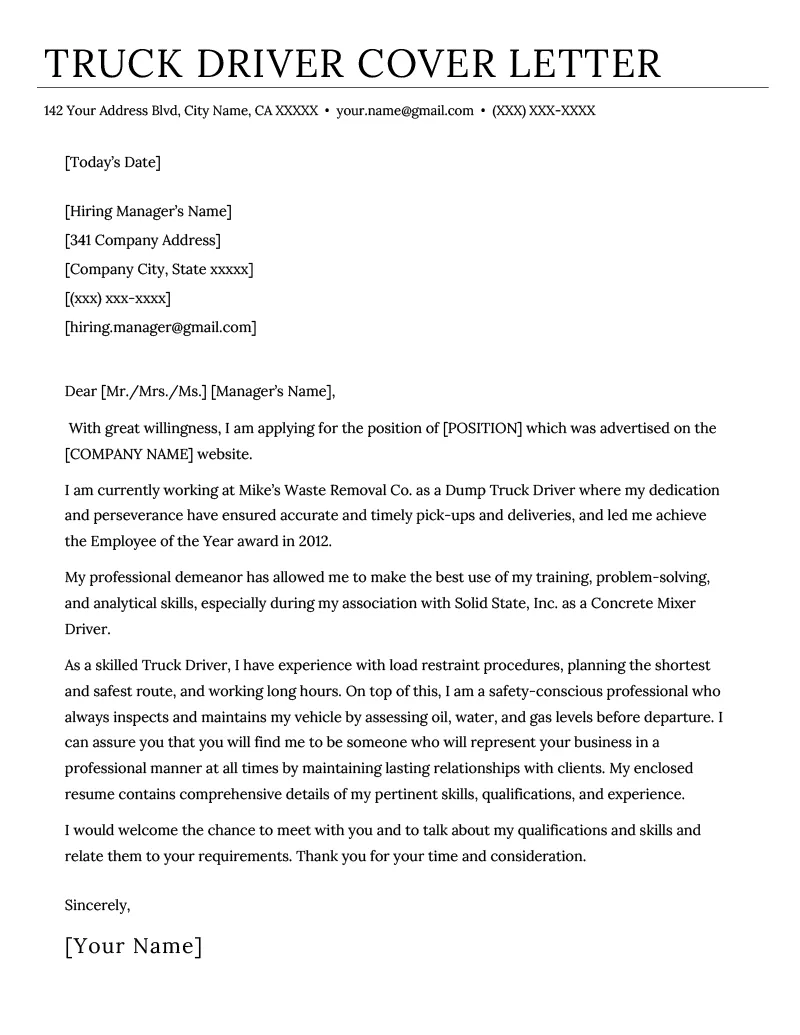
When writing your driver cover letter, it’s critical to emphasize the skills and qualifications most relevant to the job. This includes highlighting your driving experience, any certifications you hold (such as a Commercial Driver’s License - CDL), and your knowledge of safety regulations. Be sure to mention your experience with specific types of vehicles, such as tractor-trailers, buses, or delivery vans, depending on the job requirements. In addition to technical skills, also showcase your soft skills, such as your ability to follow instructions, your commitment to safety, your problem-solving abilities, and your excellent communication skills. Provide specific examples of how you’ve demonstrated these skills in previous roles, quantifying your achievements whenever possible to make your application more impactful. For instance, you could mention a record of safe driving or successful deliveries.
Essential Components of a Driver Cover Letter
A well-structured driver cover letter should include several key components to effectively convey your qualifications and interest in the position. These components work together to create a comprehensive and persuasive application that captures the hiring manager’s attention. Each part serves a specific purpose, from providing essential contact information to making a strong closing statement. Carefully crafting each element will significantly increase your chances of securing an interview and ultimately landing your desired driving job. Let’s examine the critical elements that make up a successful driver cover letter.
Contact Information
At the top of your cover letter, provide your contact information, including your full name, address, phone number, and email address. Make sure your email address is professional-sounding; avoid using nicknames or casual language. This information allows the hiring manager to easily reach you to schedule an interview or request further information. Ensure that the information you provide is accurate and up-to-date. Double-check for any typos or errors before submitting your application. Consider including a link to your LinkedIn profile if you have one, as it provides additional information about your professional background and achievements.
Professional Salutation
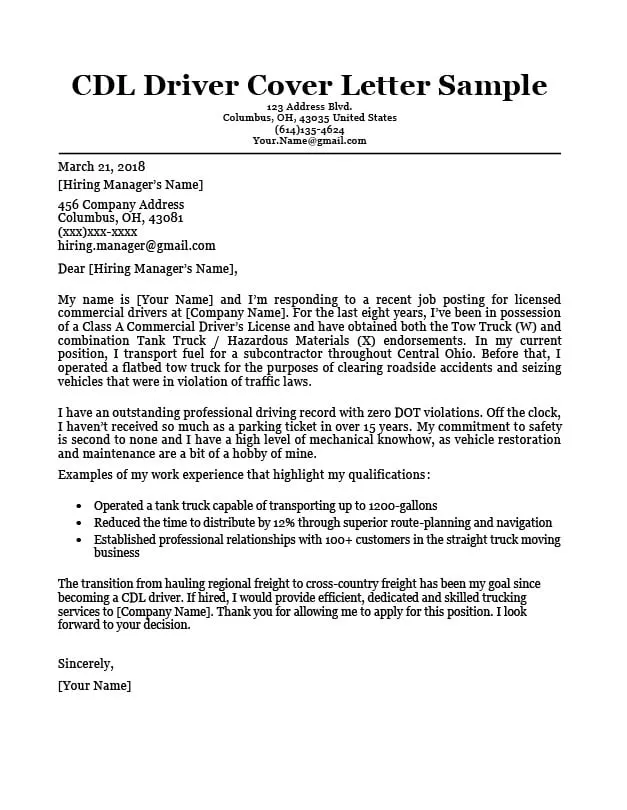
Start your cover letter with a professional salutation. If possible, address the hiring manager by name. Research the company and find out who the hiring manager is for the specific driving position you are applying for. Addressing your letter to a specific person demonstrates that you have taken the time to personalize your application. If you cannot find the name of the hiring manager, use a general salutation such as “Dear Hiring Manager” or “Dear [Company Name] Hiring Team.” Avoid using generic salutations like “To Whom It May Concern.” The salutation sets the tone for the rest of your letter, so choose a professional and respectful greeting.
Opening Paragraph
The opening paragraph is your chance to immediately grab the hiring manager’s attention. State the specific position you’re applying for and where you saw the job posting. Briefly mention your key qualifications or your most relevant experience to show why you are a strong candidate. This paragraph should be concise and focused on creating interest in reading the rest of your letter. Express your enthusiasm for the opportunity and highlight your knowledge of the company or your interest in the industry to make a positive first impression. Make it clear that you understand the job requirements and are eager to contribute your skills to the organization.
Body Paragraphs
The body paragraphs are the core of your cover letter, where you expand on your qualifications and experience. Use these paragraphs to elaborate on the skills and qualifications you highlighted in your opening paragraph. Provide specific examples of your accomplishments and how they relate to the job requirements. Quantify your achievements whenever possible. For instance, if you have a history of safe driving, provide the number of years you’ve driven without accidents. If you have experience with a particular type of vehicle, mention the specific model or make. Always tailor your content to match the job description and highlight the skills and experiences the employer is looking for. Use the STAR method (Situation, Task, Action, Result) to structure your responses and showcase your abilities effectively. Showcasing examples will help you stand out.
Closing Paragraph
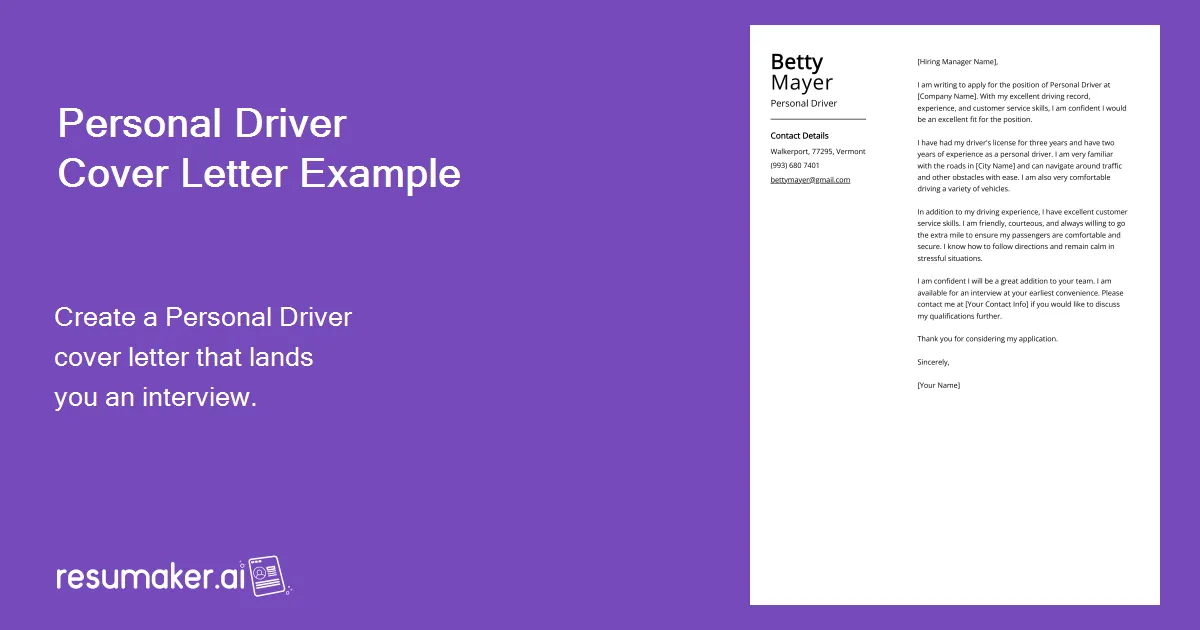
In your closing paragraph, reiterate your interest in the position and thank the hiring manager for their time and consideration. Express your availability for an interview and provide your contact information again. You can also briefly summarize your key qualifications and restate your enthusiasm for the opportunity. Be sure to include a call to action, such as stating your willingness to discuss how you can contribute to the company’s success. End with a professional closing, such as “Sincerely” or “Best regards,” followed by your full name.
Formatting and Structure
The format and structure of your driver cover letter are just as important as the content. A well-formatted letter is easier to read and makes a positive impression on the hiring manager. Proper formatting demonstrates professionalism and attention to detail, which are essential qualities for a driver. Pay attention to the layout, font, and spacing to ensure your cover letter is visually appealing and easy to navigate. A clean, organized format reflects positively on your writing skills and suggests that you take your application seriously. The appropriate formatting can significantly enhance readability.
Font Selection and Readability
Choose a professional and easy-to-read font, such as Times New Roman, Arial, or Calibri. Use a font size between 10 and 12 points for optimal readability. Avoid using overly fancy or decorative fonts, as they can be difficult to read and detract from the content of your letter. Make sure the font is consistent throughout the entire document. Use bolding sparingly to emphasize important information, such as your name or key qualifications. Proper font selection contributes to the overall visual appeal and clarity of your cover letter.
Margins and Spacing
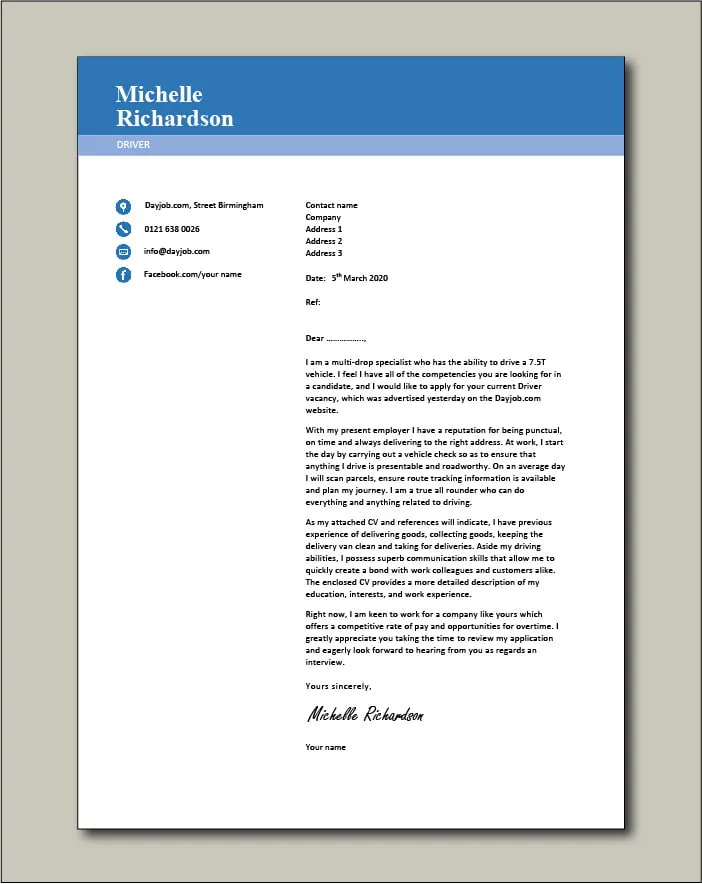
Set your margins to be at least one inch on all sides of the document. This provides ample white space, making your cover letter easier to read and less cluttered. Use single spacing within paragraphs and double spacing between paragraphs. This spacing helps to create visual breaks and improves readability. Align your text to the left, and avoid justifying the text, as this can sometimes create uneven spacing between words. Use clear and consistent spacing throughout your letter to maintain a professional and organized appearance. Remember, readability is key, and proper spacing helps achieve it.
Content and Tone
The content and tone of your driver cover letter should reflect your professionalism and your genuine interest in the position. The tone is the emotional and psychological context in which your message is received. It helps communicate information that goes beyond the literal meaning of your words. Adapt your language to suit the specific company and the nature of the driving job you are applying for. Using the right tone can help you make the right impression. Always be clear, concise, and respectful in your writing. Use positive language and avoid sounding overly casual or informal.
Tailoring Your Cover Letter
Avoid using a generic cover letter that is sent to multiple employers. Always tailor your cover letter to the specific job and company you are applying to. Research the company and the driving position to understand their needs and requirements. Address the specific skills and qualifications mentioned in the job description, and highlight how your experience aligns with those needs. This demonstrates that you have taken the time to learn about the company and are genuinely interested in the opportunity. Mentioning company values or specific projects can personalize your letter further and make it more effective. Make every cover letter unique.
Keywords and Applicant Tracking Systems
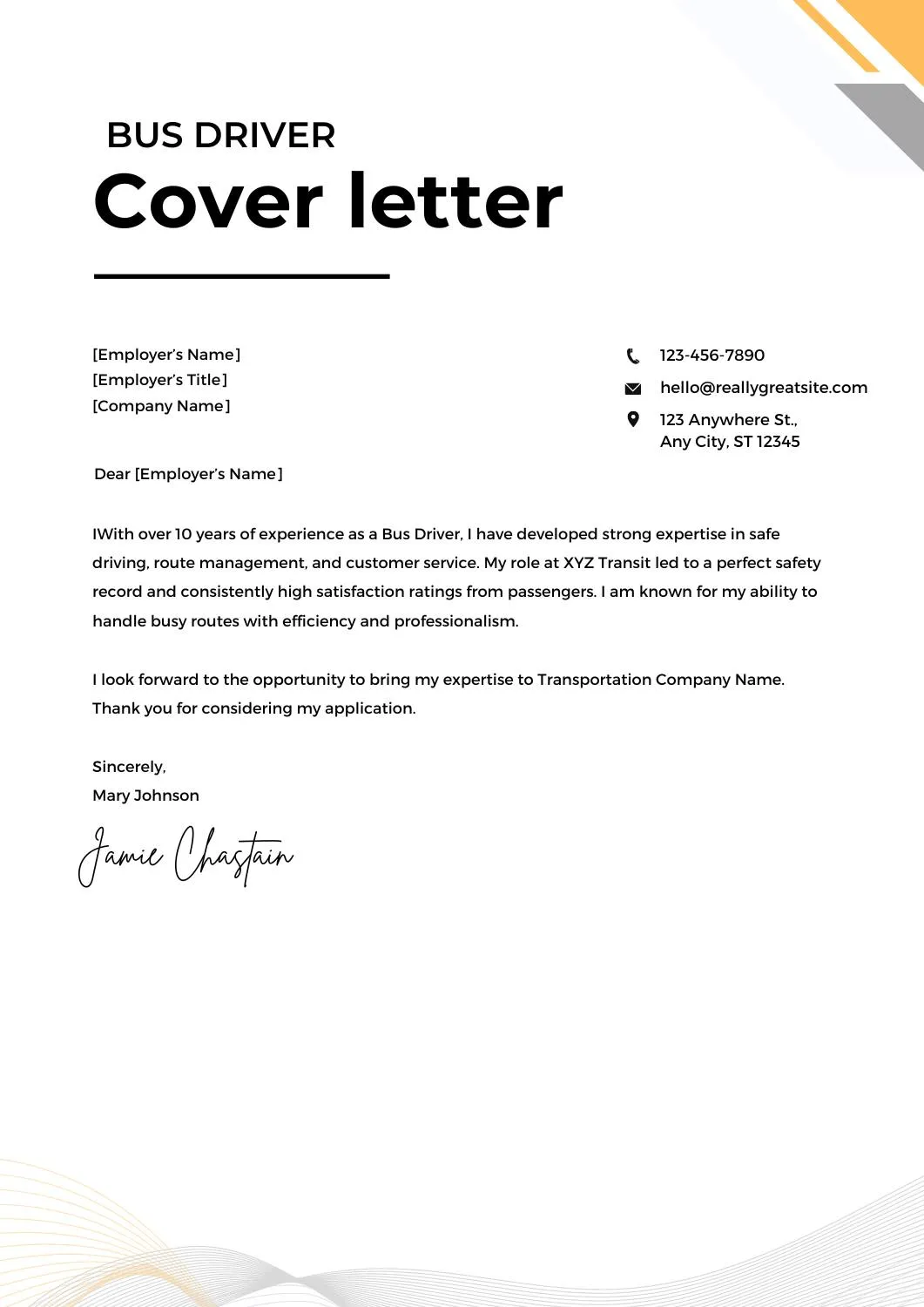
Many companies use Applicant Tracking Systems (ATS) to scan cover letters and resumes. To ensure your cover letter gets noticed, incorporate keywords from the job description throughout your letter. Identify the essential skills, qualifications, and responsibilities listed in the job posting, and use those words and phrases naturally within your writing. However, avoid keyword stuffing, which can make your letter sound unnatural and awkward. Focus on integrating keywords organically while maintaining a clear and readable tone. Keywords are helpful in an ATS system to highlight to hiring managers that you are a good match.
Proofreading and Editing
Before submitting your driver cover letter, carefully proofread and edit it for any errors in grammar, spelling, and punctuation. These errors can create a negative impression and undermine your credibility. Use a spell checker and grammar checker, but don’t rely solely on these tools. Read your letter aloud to catch any awkward phrasing or typos. Have someone else review your cover letter. A second pair of eyes can often spot errors that you might miss. Ensure that your cover letter is polished and professional before submitting it to employers. Proofreading is crucial for making a professional impression.
Common Mistakes to Avoid
There are several common mistakes to avoid when writing a driver cover letter. Ensure you do not include any irrelevant information that is not directly related to the job. Avoid using slang, jargon, or overly casual language. Do not submit a generic, mass-produced cover letter. Be sure to tailor it to each specific job you apply for. Also, avoid any negative language or complaints about previous employers or jobs. Ensure you are not using the wrong company name. Make sure there are no typos or grammatical errors. Finally, never lie about your qualifications or experience, always be truthful.
What to Exclude

When writing your driver cover letter, there are certain things you should exclude to keep the focus on your qualifications and suitability for the job. Avoid including unnecessary personal information, such as your marital status or hobbies that are not relevant to driving. Refrain from using clichés or generic phrases that don’t add value to your letter. Do not include information about salary expectations or benefits unless specifically requested in the job posting. Never include overly lengthy details about your past employers or jobs that are not relevant. Keeping your letter concise and focused on your relevant skills and experience ensures that you make the best impression on the hiring manager.
Call to Action
In conclusion, your driver cover letter is a vital tool in your job search, so taking the time to craft a compelling, well-written letter is an investment that can pay dividends. Remember to highlight your key skills and qualifications, tailor your letter to each specific job, and proofread it carefully before submitting. Always express your genuine interest in the position. Also, including a call to action is an important step to drive the process forward. State your availability for an interview and provide your contact information once again. With a well-crafted cover letter, you can significantly increase your chances of landing an interview and ultimately securing your desired driving job. Best of luck!
